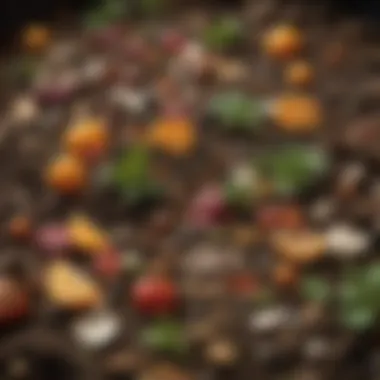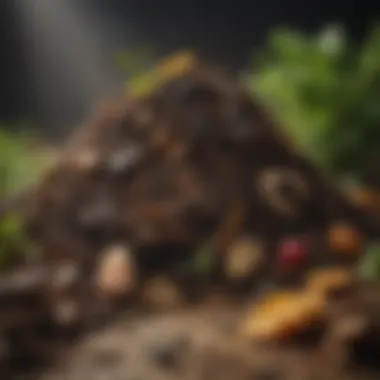Comprehensive Guide to Garden Compost Systems


Intro
Garden compost systems are more than just a way to dispose of organic waste. They represent a vital practice in sustainable gardening. This article will explore the various components and systems that can optimize gardening efforts while reducing ecological footprints. By understanding the fundamentals of composting, the reader can enhance their garden’s productivity and contribute positively to the environment.
The process of composting offers several benefits, from enriching soil to reducing waste in landfills. Understanding the types and principles allows gardeners to choose the most effective methods suited to their specific conditions. This journey into composting will also tackle common challenges faced and how to circumvent them, ensuring a smoother composting experience. As we delve deeper, we will uncover actionable insights that can be implemented directly into your gardening routines.
Understanding Composting
Composting serves as a fundamental practice in sustainable gardening. It not only aids in waste management but also enriches garden soil. Understanding the intricacies of composting is crucial for any gardener seeking to bolster their gardening efforts. It creates a circle of life in the garden, enhancing soil health while reducing the amount of waste sent to landfills.
Definition and Purpose
At its core, composting is the process of recycling organic materials. These materials often include kitchen scraps, yard waste, and other biodegradable matter. The primary purpose of composting is to create nutrient-rich soil, known as compost. This can significantly improve soil structure, enhance moisture retention, and foster beneficial microorganisms. By integrating compost into their gardening practices, individuals can support plant growth while reducing reliance on chemical fertilizers.
In practical terms, composting is not just an eco-friendly choice; it can enhance garden productivity. Farmers and gardeners notice marked improvements in plant health and yield with regular compost application. The act of composting also promotes a sense of responsibility and connection to the environment. Many gardeners report that the process deepens their understanding of biological cycles in their own ecosystems.
History of Composting
The practice of composting dates back thousands of years. Ancient civilizations recognized the benefits of using organic waste to enrich soil. Historical records suggest that the Egyptians used compost to support agriculture along the Nile River. Likewise, the Chinese incorporated fermentation processes into their farming methods as early as 4000 years ago.
In modern times, composting gained popularity in the 20th century as people became more aware of environmental issues. The rise of the organic movement in the 1960s and 1970s further propelled composting into the public consciousness. Today, composting is embraced globally, acknowledged for its role in reducing carbon footprints and mitigating waste issues.
Understanding the history of composting lends perspective on its significance. It highlights how humans have long recognized the interplay between waste and nourishment. This perspective can enrich a gardener's approach, reinforcing that composting is not merely an activity but a practice rooted in tradition and environmental stewardship.
Composting is a timeless practice that exemplifies the synergy between human activity and nature's cycles.
By recognizing its importance both historically and in contemporary society, one can appreciate the transformative potential composting holds for individual gardens and the broader environment.
Components of a Compost System
Understanding the components of a compost system is fundamental for anyone interested in creating effective garden compost. The balance between these components determines the efficiency of the composting process and the quality of the resulting product. Each element plays a specific role, contributing to the decomposition process necessary for producing rich compost.
Green Materials
Green materials, also known as nitrogen-rich materials, are crucial for the composting process. They are typically fresh and moist, deriving from elements such as grass clippings, fruit scraps, and vegetable peels. These materials provide the nitrogen necessary for microbial growth, which is essential for breaking down organic matter. The higher the nitrogen content in your compost, the faster the decomposition occurs.
Some key advantages of green materials include:
- Rapid Decomposition: Their moisture content ensures that bacteria thrive and accelerate the breakdown process.
- Nutrient Density: Green materials are often rich in nutrients, enhancing the overall quality of the compost.
However, care should be taken to balance green materials with brown materials, as too much nitrogen can lead to odor problems and other issues in your compost pile.
Brown Materials
Brown materials consist of carbon-rich components that provide energy for microorganisms. Examples include dry leaves, twigs, paper, and cardboard. These materials are dry and often contribute bulk to the compost, aiding in aeration. While they decompose more slowly than green materials, they are equally important for a successful compost system.
Here are some considerations on brown materials:
- Carbon Contribution: They are essential for balancing the carbon-to-nitrogen ratio in compost, ideally aiming for a 30:1 ratio.
- Texture Improvement: Brown materials help create a structure that maintains airflow, reducing compaction and encouraging aerobic bacteria.
Using a mix of brown materials will enhance composting, ensuring that a diverse range of nutrients is present, leading to a well-rounded compost suitable for various gardening applications.
Water and Air
Water and air are often overlooked but are essential for a thriving compost system. Decomposition requires moisture, as it aids microbial activity. However, too much water can result in anaerobic conditions, which are detrimental to the composting process.
Key points related to water and air include:
- Moisture Management: Maintaining adequate moisture levels, akin to a damp sponge, will facilitate microbial activity. Regularly check for dryness and add water if necessary.
- Aeration Importance: Turning the compost pile introduces oxygen, which is vital for aerobic microorganisms. This also helps prevent odors associated with anaerobic decomposition.


"Composting is not just an ecological service; it is part of a healthy garden ethos, enriching plant life while minimizing waste."
By carefully managing these elements, gardeners can create an efficient compost system that contributes positively to their gardening efforts.
Types of Compost Systems
Understanding the various types of compost systems is essential for both novice and experienced gardeners. Each system has unique features, advantages, and considerations, catering to different scenarios, preferences, and environmental factors. Knowing these systems enables gardeners to choose the one that aligns with their needs, ultimately enhancing composting efficiency and overall garden health. This section will delve into five primary types of compost systems: bin composting, pile composting, tumbler composting, vermicomposting, and Bokashi composting.
Bin Composting
Bin composting involves using a designated structure to contain compostable materials. This method is neat and often visually appealing in gardens. Bins can be made from various materials, including wood, plastic, or metal. One significant advantage of this method is its ability to retain heat and moisture, creating an optimal environment for microorganisms.
Regular turning of the materials inside the bin may be necessary to aerate the pile. Early-stage compost may consist of both green and brown materials, managing moisture levels can be challenging in rainier areas. Overall, bin composting is a manageable, efficient option for those with limited space.
Pile Composting
Pile composting, on the other hand, is a more informal approach. Gardeners create heaps of organic waste in a suitable location. This method is ideal for larger quantities of waste and is often used when gardeners do not want to invest in a bin. Piles can take up more space and may attract pests if not managed properly.
Similar to bin composting, regular mixing can help aerate the materials. However, maintaining a higher carbon-nitrogen ratio is crucial. Pile composting supports a more natural decomposition, contributing to the soil ecosystem.
Tumbler Composting
Tumbler composting systems are gaining popularity due to their efficiency and convenience. A compost tumbler is a sealed container mounted on an axis, which allows users to rotate it easily. This rotation aerates the compost continuously, speeding up the decomposition process.
Tumbler systems are less likely to attract pests and keep odors contained. They are particularly suitable for those with limited time or physical ability to turn a traditional compost pile. However, they typically require higher initial investment compared to other methods.
Vermicomposting
Vermicomposting utilizes worms, usually red wigglers, to process organic waste. This system is ideal for small spaces, like apartments or homes without direct garden access. It is efficient, producing rich vermicompost that can enhance plant growth.
Managing a vermicomposting system involves monitoring moisture levels and ensuring worms' well-being. This system also requires a balance between green and brown materials. Many find this method rewarding, as it not only reduces waste but also yields valuable compost.
Bokashi Composting
Bokashi composting is a fermentation process that uses specific microbes to break down organic materials. The method is particularly useful for kitchen scraps, including meat and dairy, which are typically not recommended for other composting processes.
With bokashi, waste is layered with a special inoculated bran in a sealed container, where it ferments for a few weeks. After this period, the material is buried in the soil, where it will break down further. This approach minimizes odors and space requirements. However, understanding the fermentation process is critical to success.
Benefits of Composting
Composting is often lauded as an essential practice for modern gardening. The benefits are both ecological and practical, making it a worthwhile endeavor for both casual gardeners and seasoned horticulturists. Understanding these advantages fosters a greater appreciation for composting and its role in sustananilty.
Soil Improvement
One of the primary benefits of composting is its significant impact on soil quality. Compost acts as an organic amendment that enhances soil structure. This improvement allows for better water retention, fostering an improved environment for plant roots. Furthermore, compost helps in maintaining soil pH balance, which is crucial for nutrient availability.
Adding compost increases microbial activity within the soil. Beneficial microorganisms help break down organic matter and release essential nutrients back into the soil, making them available for plants. Regular use of compost can lead to healthier plants that resist disease and stress more effectively.
Waste Reduction
Another notable advantage of composting is its role in waste reduction. According to the EPA, a significant portion of household waste consists of organic materials, including food scraps and yard waste. By composting these materials instead of discarding them in landfills, gardeners can substantially reduce their waste footprint.
Not only does this practice decrease the volume of waste sent to landfills, but it also mitigates methane emissions, a potent greenhouse gas emitted during the decomposition of organic matter in anaerobic conditions. Therefore, composting serves as an effective strategy for minimizing environmental pollution while making good use of biodegradable materials.
Nutrient Recycling
Composting promotes nutrient recycling, a crucial element in sustainable gardening. As organic materials decompose, they release vital nutrients like nitrogen, phosphorus, and potassium, which are essential for plant growth. Unlike commercial fertilizers, which can lead to nutrient leaching and soil degradation if overused, compost provides a balanced array of nutrients.
When you apply compost to your garden, you create a slow-release source of nutrients that improves overall plant health and vitality. Additionally, nutrient recycling through composting encourages a closed-loop system where waste is transformed into a resource, further supporting sustainable gardening practices.
"Composting not only enhances soil quality but also plays a critical role in environmental conservation and resource management."


In summary, the benefits of composting encompass improved soil health, reduced waste, and efficient nutrient recycling. Understanding these aspects allows both novice and experienced gardeners to make informed choices that contribute positively to their gardening ecosystems.
Optimizing Your Compost System
Optimizing your compost system is crucial for successful composting. It affects not only the quality of the compost produced but also the efficiency of the process. There are key elements to consider for optimal performance, including maintaining the right balance of materials, employing effective aeration techniques, and managing temperature. Each of these elements contributes to creating an environment that facilitates beneficial microbial activity, leading to faster decomposition.
Maintaining the Right Balance
A balanced compost pile consists of a mix of green and brown materials. Green materials provide nitrogen, while brown materials supply carbon. Finding the right ratio, generally around 30:1 carbon to nitrogen is essential. If the pile is too high in nitrogen, it may become smelly and attract pests. Conversely, too much carbon will slow the decomposition process.
To achieve this balance, you can use the following steps:
- Layering: Alternate layers of green and brown materials when building your pile. This helps in promoting even decomposition.
- Chopping: Smaller pieces break down quicker. Chop materials such as leaves and kitchen scraps to enhance decomposition.
- Moisture: Ensure that the pile is moist but not soggy. The ideal moisture content is similar to a damp sponge.
Aeration Techniques
Aeration is vital in promoting aerobic decomposition and preventing foul odors. A well-aerated compost pile allows oxygen to reach the microorganisms responsible for breaking down the organic matter. Here are some effective aeration techniques:
- Turning the Pile: Regularly turn your compost pile, every few weeks, using a pitchfork or compost turner. This helps distrubute the materials and supply fresh oxygen.
- Using Aeration Tools: Consider tools like compost aerators or perforated pipes inserted into the pile to maintain airflow.
- Piling Techniques: Create a taller pile that is more aerobic, allowing better air circulation, and using open bins can help with airflow.
Temperature Management
Temperature influences the rate of decomposition. A well-managed pile typically heats to between 130°F to 160°F (54°C to 71°C). At this temperature, pathogens are broken down, and the composting process occurs more rapidly. To manage temperature effectively:
- Monitor Regularly: Use a compost thermometer to check the internal temperature of your compost pile. This helps in identifying if adjustments are needed.
- Insulate: If temperatures drop, consider insulating your compost pile during colder months with straw or burlap.
- Watering: Drought conditions may cool the pile. Regularly check moisture and add water as necessary.
"By maintaining the right balance, employing effective aeration techniques, and properly managing temperature, you can optimize your composting process and enhance the quality of the compost produced."
Common Challenges in Composting
Composting is a natural process that transforms organic waste into nutrient-rich soil amendment. However, even seasoned gardeners encounter challenges during this process. Understanding these common issues is crucial for anyone looking to optimize their composting efforts. By recognizing potential pitfalls, gardeners can effectively manage their compost systems, ensuring the creation of high-quality compost. This section will explore three main challenges: odor issues, pest infestation, and insufficient decomposition.
Odor Issues
Odor problems are often the first sign that something is amiss in a compost pile. A well-maintained compost heap should not emit unpleasant smells. Common causes of odor include inadequate aeration, excess moisture, or an imbalance between green and brown materials.
To address an odor issue:
- Increase aeration: Turning the compost pile will introduce oxygen, helping to break down materials more effectively.
- Adjust moisture levels: A compost pile should feel damp, like a wrung-out sponge. If it’s too wet, add dry materials like shredded newspaper or leaves.
- Balance materials: Ensure a proper ratio of green materials (nitrogen-rich) to brown materials (carbon-rich). The ideal ratio is roughly 2:1.
"A stinky compost pile often indicates a problem that can be easily corrected with simple adjustments."
Pest Infestation
Pests can be a significant concern when composting, particularly in backyard systems. Rodents, raccoons, and other animals may be attracted to food scraps or a poorly managed compost pile. To prevent pest infestations:
- Secure bins: Use closed compost bins or tumblers that are less accessible to animals.
- Avoid certain materials: Do not add meat, dairy, or oily foods to compost, as these attract unwanted pests.
- Maintain proper temperatures: Keeping the compost pile at the right temperature can help deter rodents and insects, as pathogens are also eliminated at higher temperatures.
Taking these measures can greatly reduce the likelihood of pest issues.
Insufficient Decomposition
Sometimes, compost fails to break down as expected. This can be due to several factors, including inadequate moisture, lack of nitrogen, or improper particle sizes.
To enhance decomposition:
- Monitor moisture levels: Check that the pile is neither too dry nor too wet. Adjusting moisture can improve microbial activity.
- Add nitrogen: If the compost is too carbon-heavy, consider adding more green materials such as grass clippings or kitchen scraps.
- Size matters: Chop or shred large materials before adding them to the pile. Smaller pieces break down faster and more efficiently.
By tackling these common challenges, gardeners can ensure their composting efforts are successful and fruitful. Addressing issues proactively not only enhances compost quality but also contributes to a healthier garden ecosystem.
Using Compost in Your Garden


Using compost in the garden serves as a crucial step for sustainable gardening. It enriches the soil and encourages better plant health. The key elements involve understanding how compost interacts with soil, how to apply it effectively, and how it contributes to the overall health of your garden ecosystem.
Application Techniques
When utilizing compost, it is essential to consider the method of application. Here are some effective techniques:
- Top Dressing: This involves spreading a layer of compost over the surface of the soil around plants. It helps to enhance the soil structure and provides nutrients gradually.
- Soil Incorporation: Mix compost directly into the soil before planting. This works well for vegetable gardens. It improves soil aeration and moisture retention.
- Compost Tea: This liquid solution is made by steeping compost in water. Diluting it further can provide a nutrient-rich drink for plants. This method is useful for applying compost to younger plants without overwhelming them.
It is important to measure the compost used with plant needs. Over-application can result in nutrient burn, affecting plant growth. Regular soil testing can assist in determining the right quantity of compost to use.
Compost for Different Plants
Different plants have varied nutrient requirements. Consequently, knowing which plants benefit the most from compost is important:
- Vegetables: Leafy greens like lettuce and spinach can really thrive with well-matured compost. It provides essential nutrients without excess nitrogen.
- Flowering Plants: Flowers, such as roses, benefit from compost applied in spring. It can enhance their bloom and overall vigor.
- Perennials: Perennial plants appreciate compost applied in fall. It supports the root systems during dormancy.
It is also wise to consider the composition of your compost. A higher carbon brown material composition may not suit nitrogen-loving plants. Proper placement and timing of compost application will yield the best garden results.
"Compost is an essential element in the garden, contributing to soil health and plant vitality."
Utilizing compost not only supports individual plants but also enhances the garden as a whole, promoting a thriving ecosystem. Composting represents a natural solution to nutrient supply, improving biodiversity while reducing waste. Each gardener must adapt techniques and applications to fit their unique environment and specific plant needs.
Environmental Impact of Composting
The environmental impact of composting is significant in myriad ways. Composting serves as a vital component in the sustainable management of waste. It not only curtails the amount of organic matter sent to landfills but also benefits the garden soil and its surrounding ecosystem. Understanding the broader implications of composting enhances its relevance within sustainable gardening practices. There are specific benefits and considerations that highlight these impacts, particularly regarding carbon footprint reduction and promoting biodiversity.
Carbon Footprint Reduction
Composting is effective in reducing the carbon footprint associated with waste disposal. When organic waste decomposes in landfills, it produces methane, a greenhouse gas much more potent than carbon dioxide. By diverting food scraps, yard waste, and other organic materials into a compost pile, we can mitigate this scenario significantly.
- Greenhouse gas emissions are lower when organic waste decomposes aerobically in compost systems than in anaerobic conditions typical of landfills.
- Using finished compost in gardening helps sequester carbon in the soil. Healthy soil retains more carbon than soil depleted of nutrients.
- Reduced need for synthetic fertilizers contributes to carbon emission savings. These fertilizers require fossil fuel energy during their production, and opting for compost instead lessens this demand.
"Composting not only helps gardens but also plays a crucial role in combating climate change by reducing greenhouse gases."
Overall, when communities and individuals adopt composting, they contribute not just to local environmental health but also to the global fight against climate change.
Promotion of Biodiversity
Composting has a positive influence on biodiversity in several dimensions. It enhances soil health, promoting a range of organisms that contribute to a balanced ecosystem. Rich compost provides nutrients that encourage diverse microbial communities along with the growth of beneficial fungi, bacteria, and insects.
- Healthy soil supports more plant varieties. The improved soil structure allows different plants to thrive by enhancing nutrient availability.
- Contribution to pollinator habitats. Composed gardens often include a mix of flowering plants that support pollinators, such as bees and butterflies.
- Encouragement of insects and other organisms. Compost promotes earthworms and other helpful insects. They aerate the soil and help further break down organic matter.
Future Trends in Composting
As the world grapples with climate change and increasing waste levels, the importance of composting is more prominent than ever. Future trends in composting present a dynamic landscape that highlights innovations and shifts in methods suitable for diverse settings. Understanding these trends can empower gardeners and sustainability advocates to optimize their practices and contribute to environmental resilience. This section will examine technological advancements and the challenges of urban composting.
Technological Innovations
The rise of technology in composting marks a transformative phase in waste management and soil enrichment. Innovations in composting technology provide efficient and effective ways to accelerate decomposition processes, thereby increasing yields and improving soil health. One notable development is the integration of smart systems that utilize sensors to monitor moisture, temperature, and oxygen levels. Such systems offer real-time data, allowing users to make informed adjustments quickly.
Benefits of Technological Innovations:
- Enhanced Efficiency: Automated compost bins that turn and mix materials can significantly reduce processing time compared to traditional methods.
- Data-Driven Decisions: Users can actively manage conditions to create optimal decomposition environments, which helps in producing high-quality compost.
- User Accessibility: The emergence of mobile applications aids composters, providing insights and suggestions based on the materials and expected outcomes.
"As technology evolves, gardening and composting can become more precise and productive, turning waste into valuable resources with greater efficiency."
Composting in Urban Areas
Urban settings present unique challenges and opportunities for composting efforts. As cities expand, residents face limited space for traditional composting methods. However, urban composting initiatives adapt to these constraints, making composting accessible and practical for city dwellers.
Considerations for Urban Composting:
- Space-Saving Solutions: Methods such as vermicomposting, where worms are used to digest organic waste, are well-suited for small spaces like apartments.
- Community Involvement: Establishing community composting programs encourages collaboration among residents and local governments, increasing participation and compost yield.
- Education and Outreach: Ongoing education about the benefits of composting and methods tailored for city environments can raise awareness and promote sustainability.
Composting in urban areas is not just a means to manage waste. It also fosters a sense of community, encourages sustainable practices, and enhances green spaces that can significantly benefit urban ecosystems.
By embracing new technologies and adapting methods to urban realities, composting can thrive even in densely populated environments.







